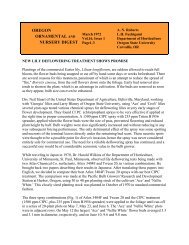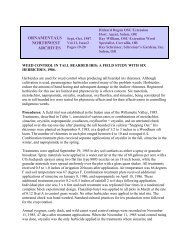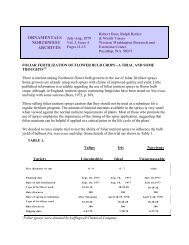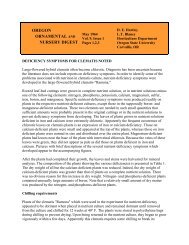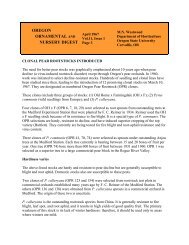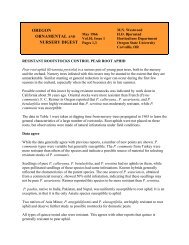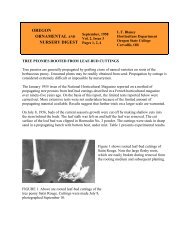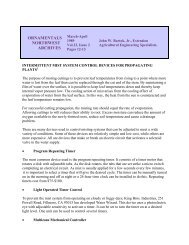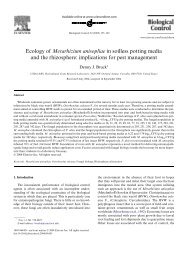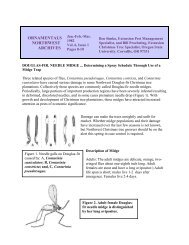Spraying Leaves of Pear Nursery Trees with Urea and Copper ...
Spraying Leaves of Pear Nursery Trees with Urea and Copper ...
Spraying Leaves of Pear Nursery Trees with Urea and Copper ...
You also want an ePaper? Increase the reach of your titles
YUMPU automatically turns print PDFs into web optimized ePapers that Google loves.
RESEARCH REPORTS<br />
concentrations as trees sprayed <strong>with</strong><br />
water became more dormant coincided<br />
<strong>with</strong> increased susceptibility to<br />
P. syringae. This supports our previous<br />
results showing that susceptibility <strong>of</strong><br />
pear trees to P. syringae increases as<br />
trees become more dormant in the autumn<br />
<strong>and</strong> early winter (Laywisadkul,<br />
2008).<br />
Our results indicate that the timing<br />
<strong>of</strong> inoculation in relation to the<br />
timing <strong>of</strong> urea <strong>and</strong> CuEDTA sprays<br />
plays a role in disease severity <strong>and</strong> is<br />
independent <strong>of</strong> the effects <strong>of</strong> urea <strong>and</strong><br />
CuEDTA on tree N concentrations.<br />
Therefore, differences in tree susceptibility<br />
to P. syringae before <strong>and</strong> after<br />
spray treatments were not related to<br />
concentrations <strong>of</strong> N <strong>and</strong> amino acids<br />
in stems. Susceptibility <strong>of</strong> pear trees to<br />
P. syringae increases as trees become<br />
more dormant in the autumn <strong>and</strong><br />
early winter (Laywisadkul, 2008). It<br />
is possible that differences in lesion<br />
development between the two inoculation<br />
times were the result <strong>of</strong> environmental<br />
differences between the<br />
two inoculation times <strong>and</strong> influence<br />
on tree dormancy <strong>and</strong> disease severity.<br />
C HEMICAL CONTROL AND<br />
SUSCEPTIBILITY. Fungicides used in<br />
our experiments effectively controlled<br />
activity <strong>of</strong> P. syringae when applied<br />
7 <strong>and</strong> 2 d before inoculation. Fungicides<br />
containing fosetyl-Al (Expt. 2)<br />
<strong>and</strong> phosphorous acid (Expt. 3) decreased<br />
disease incidence <strong>and</strong> severity<br />
<strong>of</strong> P. syringae infection on pear stems<br />
in our experiments <strong>with</strong> little (Expt.<br />
3) or no (Expt. 2) influence on stem<br />
N concentrations.<br />
In Expt. 2, spraying trees <strong>with</strong><br />
a fosetyl-Al–containing fungicides<br />
decreased disease severity <strong>with</strong>out altering<br />
N concentrations in stems or<br />
defoliation. Others have also reported<br />
fosetyl-Al has good activity against P.<br />
cactorum (Bielenin <strong>and</strong> Jones, 1988;<br />
Ellis et al., 1998; Orlikowski et al.,<br />
1986; Thomidis <strong>and</strong> Elena, 2001),<br />
P. cinnamomi (C<strong>of</strong>fey et al., 1984;<br />
Darvas et al., 1984; Matheron <strong>and</strong><br />
Mircetich, 1985; Pegg et al., 1987),<br />
P. citrophthora (Farih et al., 1981;<br />
Matheron <strong>and</strong> Mircetich, 1985), <strong>and</strong><br />
P. syringae (Doster <strong>and</strong> Bostock,<br />
1988). Our results indicate that using<br />
fosetyl-Al–containing fungicides in<br />
combination <strong>with</strong> urea or CuEDTA<br />
sprays is a compatible strategy for<br />
reducing disease caused by P. syringae<br />
<strong>with</strong>out impacting growers’ objective<br />
<strong>of</strong> increasing tree N concentrations<br />
<strong>with</strong> urea sprays or enhancing early<br />
defoliation <strong>with</strong> CuEDTA.<br />
In Expt. 3, trees sprayed <strong>with</strong><br />
a phosphorous acid-containing fungicide<br />
in October had higher stem N<br />
concentrations than trees sprayed<br />
<strong>with</strong> water. It is possible the October<br />
application <strong>of</strong> fungicide in Expt. 3 may<br />
have had a growth-stimulating influence<br />
on trees, resulting in increased N<br />
concentrations in stems. Phosphite has<br />
been reported as a nutritional <strong>and</strong><br />
fungicidal material (Guest <strong>and</strong> Grant,<br />
1991; Rickard, 2000; Varadarajan<br />
et al., 2002). Phosphite is not used as<br />
a substrate for phosphate-dependant<br />
enzymes because it is not converted<br />
to phosphate in trees (Carswell et al.,<br />
1996). However, it is not known how<br />
phosphite may alter N concentration<br />
when applied <strong>with</strong> urea + CuEDTA.<br />
Phosphite application to citrus (Citrus<br />
spp.) can cause similar increases in<br />
growth <strong>and</strong> fruit set similar to foliar<br />
sprays <strong>of</strong> urea (Lovatt, 1999). It is<br />
possible that the October application<br />
<strong>of</strong> fungicide in Expt. 3 may have had a<br />
phytotoxic effect on pear trees, causing<br />
premature leaf senescence <strong>and</strong> early<br />
mobilization <strong>of</strong> N from leaves back<br />
into stems. Although phosphite has<br />
been described as having low toxicity<br />
to plants (Guest <strong>and</strong> Grant, 1991),<br />
there are a number <strong>of</strong> reports <strong>of</strong> the<br />
development <strong>of</strong> phytotoxicity symptoms<br />
after foliar application <strong>of</strong> phosphite,<br />
including leaf burn (Walker,<br />
1989; Wicks <strong>and</strong> Hall, 1988).<br />
There are numerous reports <strong>of</strong><br />
phosphorous acid as an effective control<br />
against P. cambivora in cherry<br />
[Prunus avium (Wicks <strong>and</strong> Hall,<br />
1988)], P. cinnamomi on pineapple<br />
[Ananas comosus (Rohrback <strong>and</strong><br />
Schenck, 1985)], eucalyptus [Eucalyptus<br />
spp. (Pilbeam et al., 2000;<br />
Wilkinson et al., 2001)], <strong>and</strong> avocado<br />
[Persea americana (Pegg et al.,<br />
1987)], P. citrophthora in citrus<br />
(Afek <strong>and</strong> Sztejnberg, 1989), <strong>and</strong> P.<br />
palmivora in cacao [Theobroma cacao<br />
(Holderness, 1990)]. Our results indicate<br />
that using phosphorous acid in<br />
combination <strong>with</strong> urea or CuEDTA<br />
sprays is a compatible strategy for<br />
reducing disease caused by P. syringae<br />
<strong>and</strong> the timing <strong>of</strong> phosphorous acid<br />
sprays in relation to urea or CuEDTA<br />
sprays will not influence its effects on<br />
disease control.<br />
CONCLUSIONS. <strong>Spraying</strong> pear<br />
‘OHF 97’ rootstock in the autumn<br />
<strong>with</strong> urea, defoliants, or fungicides<br />
containing fosetyl-Al or phosphite<br />
may influence tree N concentration,<br />
but their effects on N concentration<br />
are not directly related to susceptibility<br />
to P. syringae. <strong>Spraying</strong> pear trees<br />
<strong>with</strong> a combination <strong>of</strong> urea <strong>and</strong><br />
CuEDTA after terminal buds have<br />
set in early autumn (October in<br />
PNW) can benefit nurserymen because<br />
the pathogen is less active in<br />
warm dry environments <strong>and</strong> the<br />
trees are better able to heal wounds<br />
caused by defoliation or chemical<br />
treatments. <strong>Trees</strong> sprayed in October<br />
have lower N reserves compared <strong>with</strong><br />
trees sprayed in November or naturally<br />
defoliated trees; therefore, spraying<br />
trees in October will not have as<br />
much <strong>of</strong> a positive influence on tree<br />
growth the following year. Additionally,<br />
spraying trees <strong>with</strong> a combination<br />
<strong>of</strong> urea <strong>and</strong> CuEDTA <strong>with</strong> phosphonate-containing<br />
fungicides in early<br />
autumn can be <strong>of</strong> benefit for early<br />
harvesting <strong>and</strong> preventing the contamination<br />
<strong>and</strong>/or infection <strong>of</strong> P.<br />
syringae in the field or storage.<br />
Literature cited<br />
Afek, U. <strong>and</strong> A. Sztejnberg. 1989. Effect<br />
<strong>of</strong> fosetyl-Al <strong>and</strong> phosphorous acid on<br />
scoporone, a phytoalexin associated<br />
<strong>with</strong> resistance <strong>of</strong> citrus to Phytophthora<br />
citrophthora. Phytopathology 79:736–<br />
739.<br />
Apple, J.L. 1962. The development <strong>of</strong><br />
black shank in tobacco as influenced by<br />
host nutrition. Phytopathology 51:386–<br />
389.<br />
Bi, G., C.F. Scagel, L. Cheng, <strong>and</strong> L.H.<br />
Fuchigami. 2005. Effects <strong>of</strong> copper, zinc,<br />
<strong>and</strong> urea on defoliation <strong>and</strong> nitrogen reserves<br />
in nursery plants <strong>of</strong> almond.<br />
J. Hort. Sci. Biotechnol. 80:746–750.<br />
Bi, G., C.F. Scagel, L. Cheng, S. Dong,<br />
<strong>and</strong> L.H. Fuchigami. 2003. Spring<br />
growth <strong>of</strong> almond nursery trees depends<br />
upon nitrogen from both plant reserves<br />
<strong>and</strong> spring fertilizer application. J. Hort.<br />
Sci. Biotechnol. 78:853–858.<br />
Bielenin, A. <strong>and</strong> A.L. Jones. 1988. Efficacy<br />
<strong>of</strong> sprays <strong>of</strong> fosetyl-Al <strong>and</strong> drenches <strong>of</strong><br />
metalaxyl for the control <strong>of</strong> Phytophthora<br />
root <strong>and</strong> crown rot <strong>of</strong> cherry. Plant Dis.<br />
72:477–480.<br />
Bostock, R.M. <strong>and</strong> M.A. Doster. 1985.<br />
Association <strong>of</strong> Phytophthora syringae <strong>with</strong><br />
pruning wound cankers <strong>of</strong> almond trees.<br />
Plant Dis. 69:568–571.<br />
Carswell, C., B.R. Grant, M.E. Theodorou,<br />
J.Harris,J.O.Niere,<strong>and</strong>W.C.Plaxton.<br />
340 • April 2010 20(2)





